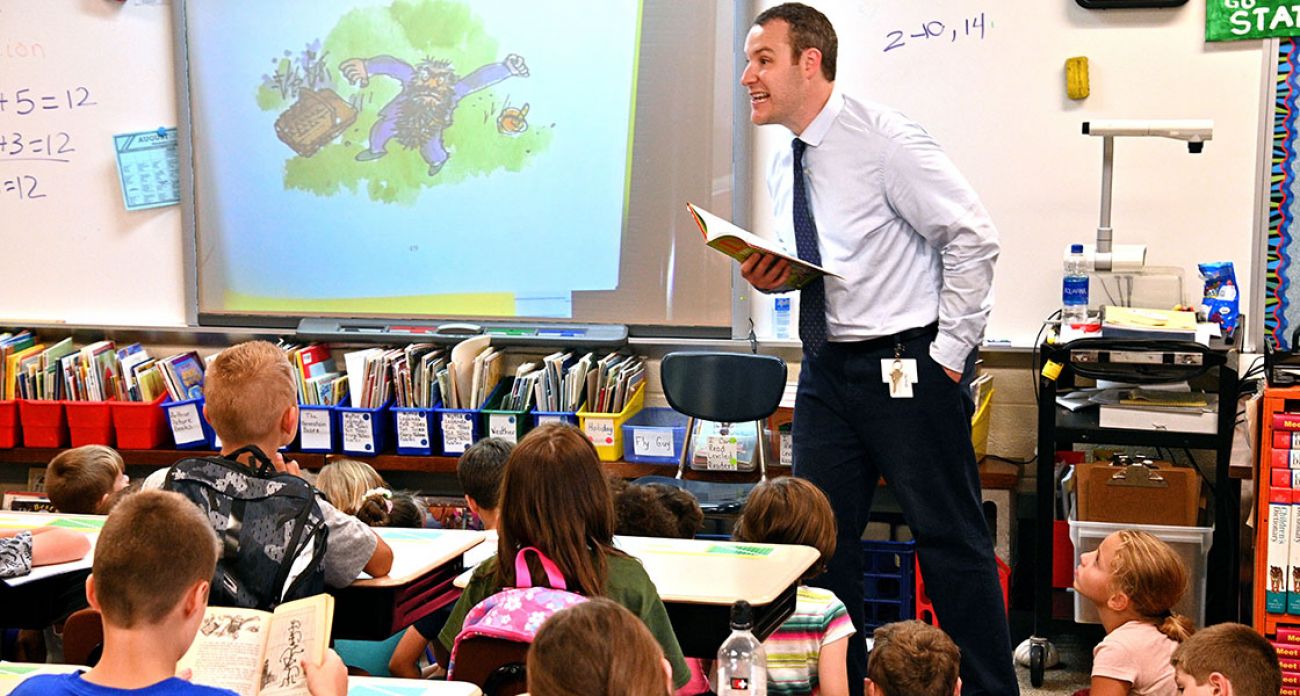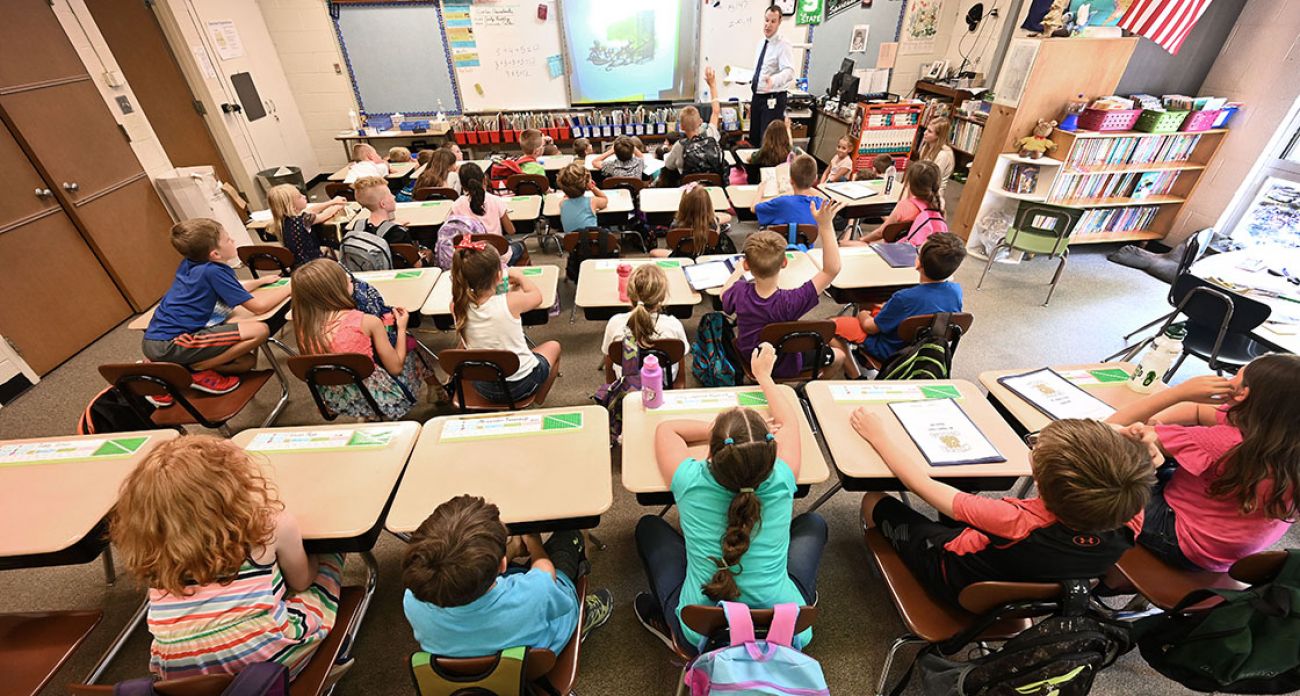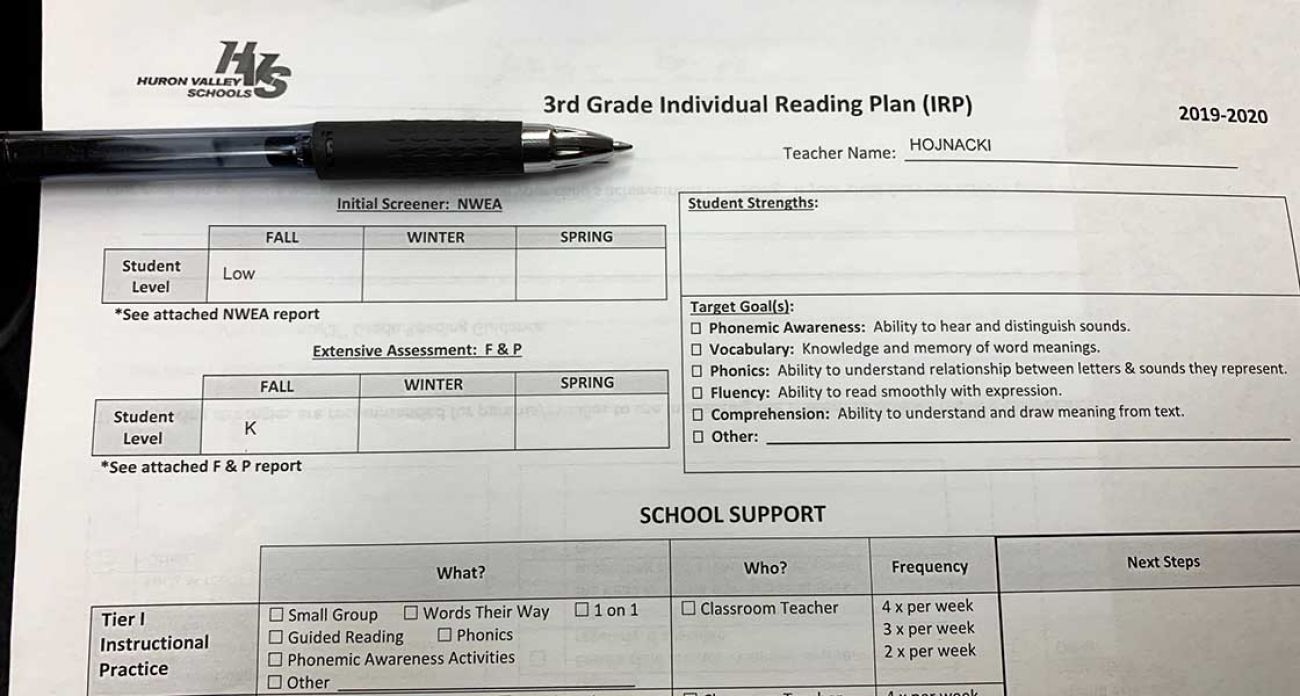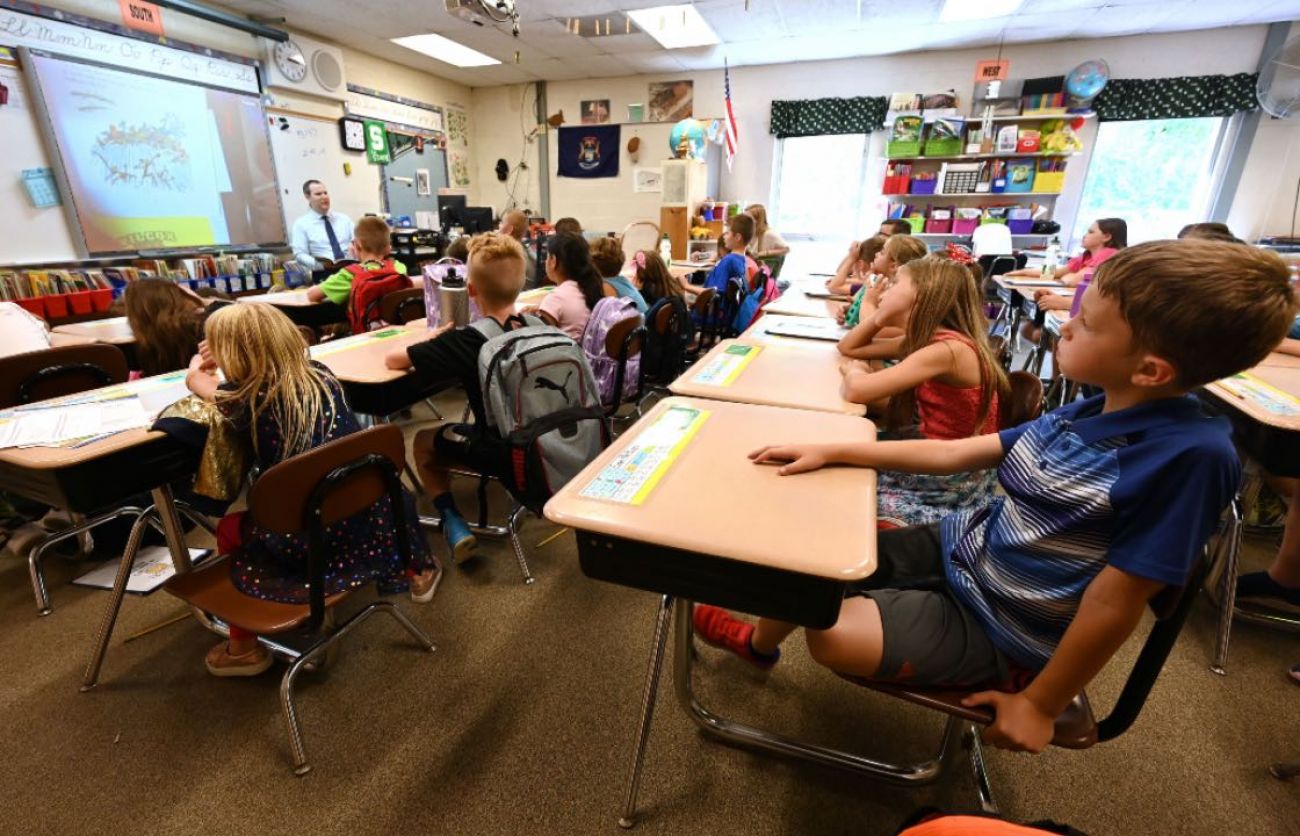The Test: ‘Read-or-flunk’ law looms over Michigan third-graders





















Tara Olar’s fingers flit across a stack of manila folders in her empty classroom at Mayville Elementary School. Her third-grade students are down the hall in the school’s computer lab taking a test that measures their reading ability ‒ their third reading test in their first month of class. Two weeks earlier, the same students had taken a different reading evaluation conducted by a district instructor who works with low-income children.
The folders on Olar’s desk, one for each third-grader in the small rural school in Michigan’s thumb, contain yet a third way to measure students’ reading skills. The folders are thin on this warm day in late September, holding only a few sheets of paper from a diagnostic test conducted by Olar herself, one 8-year-old at a time in the back of her colorful classroom.
By the end of third grade, these folders will bulge with scores and notes, building toward the final test of the year.
“Everything,” Olar said, “is geared toward that test.”
That test is Michigan’s end-of-school-year standardized test, the M-STEP. For the first time, it will be used to determine which Michigan third-graders should advance to fourth grade and which will be recommended to be retained in third grade because of a low reading score.
An estimated 5,000 children – about one in 20 Michigan third-graders – may be held back under what’s come to be known as the read-or-flunk law, according to projections by the Michigan Department of Education.
For 8- and 9-year-olds who struggle with reading, the pressure could be extraordinary.
But they are not the only ones sweating. Their performance this year will also be a test for Michigan’s third-grade teachers, who must push their students above the cutoff score to move on to fourth grade. For schools, which are devoting more resources to early reading and now will find out if they worked. And for the state, which has struggled to boost the academic performance of its public schools that languish in the bottom third in the nation.
Bridge Magazine is following four third-grade classrooms to chronicle how teachers, students and their parents prepare for the test. Over the year, Bridge will publish reports from classrooms in Mayville, a small farming community east of Saginaw; Pontiac, a low-income urban district; Huron Valley, an affluent exurban district in Oakland County; and Holt, a school system south of Lansing with a mix of affluent and low-income students.
Among the almost 100 students in those four classes, there are children of highly-educated professionals and children who are homeless. Some will get reading help from teams of adults armed with data dissecting their strengths and weaknesses; others will have only their classroom teacher to lean on.
All will take the same high-stakes test in May.

Pontiac schools
District enrollment: 4,056
Third-grade reading proficiency: 12 percent
School district's demography:
Poor: 79.6 percent
White: 7.1 percent
Black: 51.8 percent
Hispanic: 34.3 percent
Asian: 3 percent
Other race: 3.7 percent
Median household income: $36,332 ($52,668 statewide)
Angela Okagbare knew she was facing an uphill battle this school year long before she arrived at her Pontiac classroom at 7 a.m. in late August. Students wouldn’t report for another six days, but the 23-year veteran teacher had been coming to her classroom at International Technology Academy magnet school most days for a month.
On this day, she was unpacking books donated by a community group. She separated the books by reading level and put them in milk crates and multicolored baskets she purchased at Menards. She spent about $100 of her own money to brighten up her third-grade classroom for her 25 students who live in one of the poorest cities in the state.
Last year, 63 percent of Pontiac third-graders were “not proficient” on the English language arts section of the M-STEP, which includes reading. To be held back, students must perform even worse than “not proficient,” but in a high-poverty, low-performing school districts like Pontiac, the retention rate is expected to be far higher than the state average of 5 percent.
It could be still worse at Okagbare’s school, in a neighborhood of small businesses and smaller homes. This year’s class had four different teachers when they were in second grade. The teacher assigned to the classroom left shortly after school started, and was followed by two long-term substitutes (who typically do not have a teaching certificate), and then by a certified teacher in the spring.
That lack of consistency was reflected in low reading scores in second grade. Okagbare was going to have to try to catch up those kids by next May, when the M-STEP is given.

Why third grade matters
Researchers and educators agree that a child’s reading level in third grade is a key indicator of future academic success. Among students who are reading behind grade-level by the end of third grade, 74 percent never catch up with classmates, and graduate high school at lower rates.
Education experts view improving third-grade reading as a way to turn around Michigan schools. Which is why, in October 2016, the Michigan Legislature passed a law requiring students who are more than a grade level behind in reading by the end of third grade to be retained, joining 15 other states with similar read-or-flunk laws. The sponsor of the bill, former Rep. Amanda Price, a Republican from Ottawa County who chaired the House Education Committee, said she hoped the bill would help low-income children, who often have lower reading scores than their affluent classmates.
“I cry when I see these lives being wasted,” Price said in 2018. “I don’t think the average parent knows where we are with literacy.”
The policy didn’t kick in until this fall – a three-year delay intended to allow the state Department of Education to establish grade-level assessments from M-STEP scores, and give schools time to improve early reading skills.
The law also included money to boost early-grade literacy efforts.
“My hope is that kids are never held back,” Price told Bridge in 2018. “You have kindergarten, first, second and third grades to get kids to read. In my mind, we ought to be at 95 percent proficiency.”
But we aren’t.

‘Playing catch-up’
Despite at least $80 million spent on early reading efforts since the law was passed in the fall of 2016, the share of struggling readers in third grade hasn’t budged. In the 2015-16 school year, before the law was passed, 29 percent of third-graders were rated “not proficient” in English language arts on the M-STEP. In 2018-19, 30 percent were “not proficient.”
MDE projects that about 5 percent of Michigan public school students will be held back because of poor reading skills. None will likely flunk in some districts with high academic achievement, while many will likely be retained in some high-poverty, low-achieving urban school districts.
In fact, black students are projected to be held back at four times the rate of white students, according to a startling Michigan State University study that examined recent reading test scores. Likewise, children from low-income families will be four times more likely to be retained than their non-poor classmates.
The vast majority of students in Pontiac where Okagbare teaches are both poor and minority.
“You have those kids that are in [affluent] districts that have parents that value education, that have college behind them, and so they teach their children early on that you need an education to be able to get ahead in this world,” Okagbare said. In Pontiac, “it’s like we’re playing catch-up the entire time.”

Huron Valley schools
District enrollment: 8,850
Third-grade reading proficiency: 77 percent
School district's demography:
Poor: 27.3 percent
White: 89.8 percent
Black: 1.3 percent
Hispanic: 4.6 percent
Asian: 1.4 percent
Other race: 3 percent
Median household income: $101,909 ($52,668 statewide)
On that same August day, 11 miles and $65,000 in median household income away from Pontiac, SUVs and minivans filled the parking lot of Lakewood Elementary for a beginning-of-year open house. In the third-grade classroom of Michele Hojnacki, 8-year-olds checked out the desks they’d sit at when school began the following week. Hojnacki hugged her future students and posed for selfies.
Students in her class have changed since Hojnacki walked into her first third-grade classroom 26 years ago. Back then, Huron Valley Schools, located in Highland and White Lake Township in western Oakland County, was filled with farm kids. Most of those farms have been replaced with subdivisions and chain restaurants. Long gone are the days when Hojnacki once had to conduct a reading intervention meeting with a parent in the pick-up line outside her elementary. Now, parents in this community with a median household income almost twice that of the state are eager to be involved in their children’s education.
After the children and their parents left, Hojnacki looked at a printout of her future students’ reading test scores from second grade. Some were behind grade level.
“In all my years, I’ve held back one student, and even then we left it up to the parent,” Hojnacki said. “Developmentally, some children just take a little longer. And that’s OK. And maybe you’re not a great reader, but you’re really good at questioning – an engineering mind works that way. I can’t turn on different centers of the brain with a key.”

Holt schools
District enrollment: 5,521
Third-grade reading proficiency: 54 percent
School district's demography:
Poor: 43.6 percent
White: 65.7 percent
Black: 11.2 percent
Hispanic: 14.6 percent
Asian: 3.3 percent
Other race: 5.2 percent
Median household income: $61,495 ($52,668 statewide)
School was already in session in late August at Wilcox Elementary in Holt. Third-graders in one classroom paid rapt attention as teacher Michael Adams read aloud the Roald Dahl book “The Twits,” using a variety of funny voices for the characters.
When one student’s attention strayed, Adams stopped, and he switched to a stern teacher voice.
“I will give you every bit of me,” Adams said, “but you’ve got to give me every bit of you.”
Adams rarely watches TV. He never texts and uses email only at gunpoint. What he does do is read. He and his wife often read a book at the same time so they can talk about it like others discuss the latest episode of “The Bachelor.”
Adams is in his ninth year as a teacher. His class of 24 third-graders this year is a reflection of 5,500-student Holt Public Schools, a mix of affluent suburban kids and children from families struggling financially. The district’s third-grade test scores are above the state average, with 54 percent of students proficient or better in English language arts in 2018-19, compared to 45 percent statewide. Still, one in five third-graders were “not proficient,” the lowest rating category on the test.
“I view this year as the same as I viewed every single year that I've ever taught,” Adams said. “I do my very best when I come through the door, and I do my very best to prepare. It’s not like I'm suddenly going to become a better teacher, because of this law.”
Adams admitted though that stakes are higher this year for his students because of the read-or-flunk law, and the stern teacher voice returns.
“The legislators in Lansing don't understand that there are children who simply can't meet the high demand that they have put in front of them. And I can tell you, it breaks my heart.
“I can tell a child, ‘Why don’t you just come do your work and make that a break from the chaos at home,’ but if your life is in turmoil, how can I expect them to come in here and do the same work as a child who goes home to a four-bedroom home with a finished basement and parents who have the time to devote to reading? I could cry thinking about that.”

‘The tests never end’
A month into the first school year in which Michigan third-graders could be held back because of poor reading skills, Huron Valley School’s Hojnacki still hadn’t led any small group or one-on-one reading lessons.
Instead, her class at Lakewood Elementary spent much of September taking reading tests.
During the first month of the school year, Hojnacki spent a total of 15 hours of class time conducting individual diagnostic reading tests with her 24 students to determine their reading level, during which the rest of the class was not receiving new academic instruction.
She and other third-grade teachers at Lakewood conducted those in-class tests even though their students had also taken another, computerized reading test in September.
The test redundancy illustrates the importance her district and the Michigan Department of Education place on third-grade reading. But because of the time required, Hojnacki didn’t begin teaching reading to her class until October.
In essence, reading skill testing had removed a full month of reading instruction for third-graders who, in May, could be retained in third grade if they are still poor readers.
“I understand we need data and we need the information,” Hojnacki said. “But it’s a lot of time away from teaching and real learning.”
By mid-October, students in Michael Adams’ third-grade class at Wilcox Elementary in Holt had taken four tests measuring their reading level. “And the kids on the low end have had another test,” Adams said, “so some have had five. It’s brutal. The tests never end.”
The number of tests taken so far this fall by third-graders varies by school district.
All, at minimum, have taken a computerized test that projects how they fare in reading compared to their peers across the state. Though the specific test varies among schools, that type of test is required of third-graders at the start of the school year and in January.
Some students shrug off the nonstop tests, Adams said, while others “pick up on the third-grade stress.”
“There’s definitely an issue with test fatigue,” Adams said, “where you test the kids so much, they begin to think that all instruction is a test.”
The looming read-or-flunk test cast a shadow over instruction in Pontiac in October. Okagbare bounced from one cluster of desks to another helping students read or pick out books, giving high-fives like a football coach after a touchdown.
“I feel a little more stress this year,” Okagbare said. “I still have to make sure I teach math and science, social studies, all of that. But I feel like I need to concentrate more on reading because of the law.”
Back in Mayville in the thumb, on a day when the high school football team was readying for the homecoming game, third-graders were in a computer lab taking a reading test. Olar teaches reading and social studies, but in recent years, the statewide push to improve reading skills has crimped the lessons she loves to teach about Michigan history.
All four teachers visited by Bridge said the paperwork associated with testing adds hours to their work week. Adams said he sometimes wants to “bang my head against a wall,” while Huron Valley’s Hojnacki described some of the paperwork and testing as “CYA to show the state we’re doing it.”
“All of the testing pulls away from my instructional time,” Hojnacki said, “and I’m not going to have [student reading] growth if I’m not teaching.”

Mayville schools
District enrollment: 4,056
Third-grade reading proficiency: 47 percent
School district's demography:
Poor: 73.5 percent
White: 91.9 percent
Black: 0.8 percent
Hispanic: 5.4 percent
Asian: 0.5 percent
Other race: 1.4 percent
Median household income: $53,137 ($52,668 statewide)
With the first round of tests of the school year complete in early October, third-grade teachers calculated how many of their students were reading below grade level.
Fourteen of the 25 students in Okagbare’s classroom in Pontiac had dangerously low test scores. Eight students in Huron Valley’s Hojnacki’s class were behind.
In Mayville, half of the school’s 38 third-graders were reading below grade level.
Olar splits third-grade teaching duties with another teacher in the one-story school in a village of 950 people. Classroom walls are covered in posters about adjectives and nouns. A list of vocabulary words is pinned to pink paper: atmosphere and astounding under A, meandering and monstrous under M; impertinence under I.
She reads to the class daily (“The Wind in the Willows” on a September day), stopping to ask questions about the characters, and works individually with students who are writing about the book.
Despite her efforts, reading remained a challenge for some of her students, some of whom may be in danger of being retained in grade. “I don’t know if that will benefit these kiddos or not because of the social aspect (of being left behind),” Olar said. “They’re going to feel bad.”
Olar looked at the folders on her desk and grimaced. One student had dropped two grade levels in reading over the summer. Another is reading at kindergarten level.
“I’m going to have to put extra time into those kiddos who are struggling,” Olar said.

“I know a lot of people are upset about the third-grade law. It’s putting a lot of pressure on third-grade teachers to pull up their bootstraps and get to work.
“I think I’m a good teacher,” she said, “but I’m not Superwoman.”
How will parents react?
“You are the best class!” Huron Valley’s Hojnacki exclaimed. “You’re so good, what do I have to do?”
“Pinch yourself!” screamed 24 students sitting cross-legged on the carpet of the third-grade class.
“To see what?”
“To see if you’re dreaming!”
Seven weeks into the school year, the veteran teacher and her crew of 8- and 9-year-olds had developed a comfortable rapport.
Still, a third of the class was below grade level in reading.
On an October afternoon, she met with the school’s literacy coach to go over the paperwork Hojnacki will need to present to parents whose third-grade children are struggling to read. The paperwork will lay out the school’s plan to help the students. Hojnacki will also inform parents of the possibility that their children, part of her “dream” class, could be recommended at year-end to repeat third grade if their reading doesn’t improve.
She worried what will happen to her now-happy class when letters citing below-grade-level reading reach parents.
“My fear is that parents may put that on their child – ‘You have to read tonight so you don’t have to do third grade again.’ That could be devastating.
“The thing I like most about teaching is not the academics, it’s building someone up, making someone feel good,” Hojnacki said. “You can’t learn if you don’t feel good. And this law isn’t going to make children feel good.”
Michigan Education Watch
Michigan Education Watch is made possible by generous financial support from:
Subscribe to Michigan Education Watch
See what new members are saying about why they donated to Bridge Michigan:
- “In order for this information to be accurate and unbiased it must be underwritten by its readers, not by special interests.” - Larry S.
- “Not many other media sources report on the topics Bridge does.” - Susan B.
- “Your journalism is outstanding and rare these days.” - Mark S.
If you want to ensure the future of nonpartisan, nonprofit Michigan journalism, please become a member today. You, too, will be asked why you donated and maybe we'll feature your quote next time!






